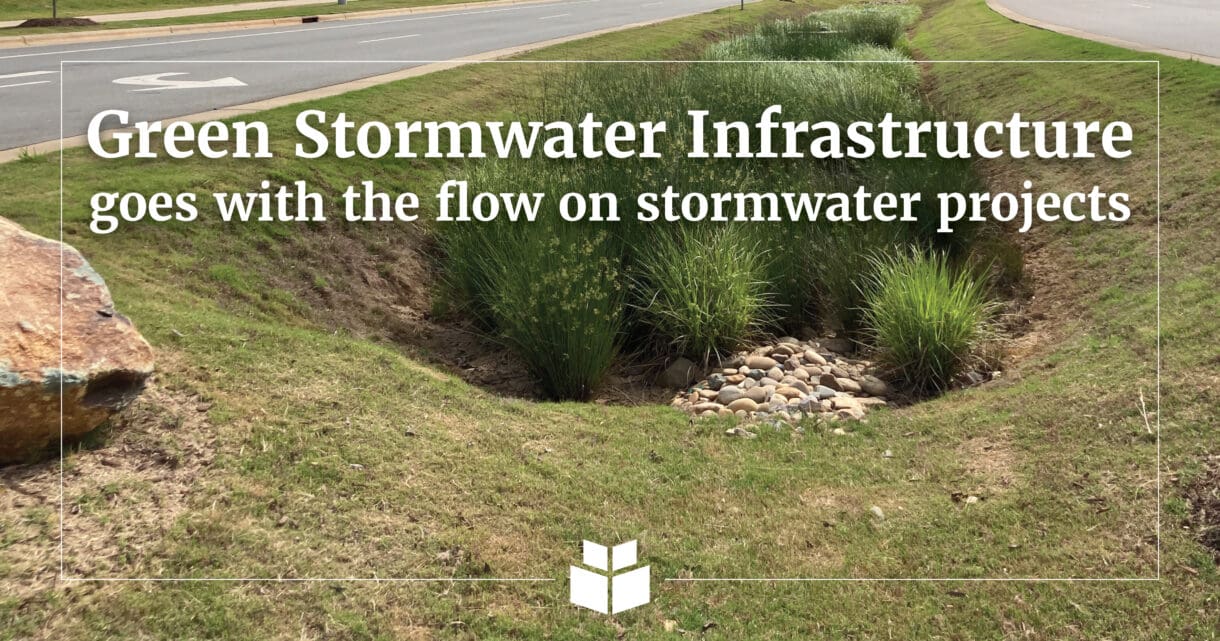
With increasing environmental challenges brought on by a changing climate and more intense storms, such as Hurricane Helene last year, green stormwater infrastructure (GSI) has emerged as a vital tool in promoting sustainability, cost efficiency, and healthier ecosystems.
But why is GSI so crucial, and how does it benefit both the planet and local neighborhoods?
“GSI is generally known for promoting groundwater recharge and utilizing ecosystems to ‘consume’ excess nutrient runoff,” according to WithersRavenel Stormwater Project Manager Brandon Miller, PE, who focuses on providing green infrastructure solutions in many of our projects.
“GSI is best used in strategic locations to perform the heavy lift of nutrient removal and infiltration, while directing higher flows to larger detention facilities when necessary.”
One of its biggest advantages is adaptability, especially in retrofitting projects where new regulations or expansions demand additional runoff treatment. “GSI can be a cost-effective way to treat previously untreated runoff without disrupting an existing site,” Brandon said.
Geographic suitability
WithersRavenel’s stormwater team works on North Carolina projects from the mountains to the ocean, so conditions can vary significantly. There are three major Nutrient Sensitive Watersheds (NSW) in North Carolina: Tar-Pamlico, Falls Lake-Neuse River, and Jordan Lake. Tar-Pamlico and Falls Lake require phosphorus reduction as well as nitrogen, and “GSI practices are immensely helpful” in those NSWs, said Brandon.
Even in areas with poor infiltration, such as Piedmont clay soils, alternatives like vegetated swales and rain gardens provide effective solutions. “From a permitting perspective, these aesthetically attractive ‘rain gardens’ can serve as treatment measures in series, which goes a long way,” Brandon said.
GSI, an obvious choice
In many instances, GSI is the most obvious choice in stormwater projects, especially as more communities enforce Stormwater Nitrogen and Phosphorus (SNAP) rules.
With stricter stormwater regulations, WithersRavenel often tackles projects that aim for 100 percent impervious surface capture, with our engineers frequently using rear-yard swales. “Our stormwater group has begun tracking those swales for nutrient loading calculations,” said Brandon, who believes this reduces mitigation costs, ultimately saving fees for development clients. “When working in Tar-Pamlico or Falls Lake, the use of rain gardens and in-series structures is almost always necessary.”
Brandon cautions that not every project needs a GSI. “Often for residential projects, I think of them as a way to amenitize areas: flower beds, open space infiltration basins, or even underground infiltration, where the surface can be used for raised gardens, play fields, or other attractions.”
Successful implementation
WithersRavenel’s stormwater team has successfully implemented GSI in several projects, where the effectiveness has been felt. The Beau Coast development utilizes permeable pavement to reduce runoff, primarily in pockets of the community where regional Stormwater Control Measures (SCMs) are not ideal. In the Chatham Park Development, according to Brandon, WithersRavenel incorporated a variety of GSI techniques, including right-of-way tree wells, bioretention, rainwater capture and reuse, and tree canopy and open space conservation.
Brandon highlighted our team’s success working for the North Carolina State Ports Authority (NCSPA) in Wilmington, where a permeable pavement was installed in an office parking lot. “They needed to expand an area within the shipping yard, and converted their office parking lot into infiltrative permeable pavement as a treatment area swap since the shipping yard is not convenient for an SCM,” he said.
While development continues, Brandon sees even greater potential for integrating GSI into broader planning. “As WithersRavenel grows its project development group, where we can look at things from a 10,000-foot perspective, I think we will be able to incorporate more GSI practices, allowing our stormwater plans to be an interesting and comprehensive way of approaching runoff treatment and control,” he said.
The long-term challenge is maintenance, but he is optimistic. “Many landscapers are already trained to look after these structures, and (they) can be seamlessly added to their regular duties.”
Green stormwater infrastructure, so far, has held up the promise of sustainable stormwater management, as new practices and ideas seep in.
Reach out to Project Manager Brandon Miller at bmiller@withersravenel.com if you would like to brainstorm ideas for your next stormwater project.
